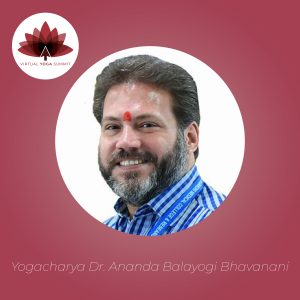
Yogacharya Dr. Ananda Balayogi Bhavanani is Director of the Centre for Yoga Therapy Education and Research, and professor of yoga therapy at the Sri Balaji Vidyapeeth University, Pondicherry. A recipient of the coveted DSc in yoga from SVYASA Yoga University in January 2019, he is chairman of the International Centre for Yoga Education and Research at Ananda Ashram, and Yoganjali Natyalayam, the premier institute of yoga and Carnatic music and Bharatanatyam in Pondicherry.
In this video, as well as in the below article, he talks about the benefits of yoga for children, and how regular practice can help enhance emotional intelligence.
CONCEPTS AND METHODS OF TEACHING YOGA TO CHILDREN
The art and science of Yoga has a lot to offer for children in terms of their health as well as complete wellbeing. Yoga offers us a tool by which we can provide a safe and healthy future for our beloved children. Yoga is both preventive as well as therapeutic for health problems that children face and is also rehabilitative in many situations. It is also important to understand the special needs of the children when teaching them and methods to create interest in them for this great jewel of our cultural heritage.
Yoga helps children cultivate conscious awareness, increases self-awareness and self-confidence. It teaches children to be gentle with themselves and others and develops focus and concentration. It also develops balance and mental equilibrium along with discipline and a love of learning. It improves performance in all areas of life, including schoolwork and relieves stress while providing a greater sense of general well-being. A regular practice of Yoga increases flexibility, coordination, and strength of the children and assists in the performance of sports activities.
HEALTH NEEDS OF CHILDREN
Children are a unique segment of our population and have very specific health needs. Childhood is the age of both physical and mental growth and also has stressful periods such as puberty and adolescence that affect the health of the growing child and youth.
Some of the important health problems facing the child population are:
- Growth and endocrine disorders
- Infectious diseases
- Handicaps
- Physical handicaps
- Neurological handicaps
- Sensory handicaps
- Social handicaps
- Congenital disorders
- Chronic diseases of the respiratory tract and heart
- Neurological disorders
- Liver and renal disorders
- Psychological disorders
- Skin diseases
- Children also need an outlet for their creativity and abundant energy and if this youthful energy isn’t canalized properly it may result in various socially deviant behaviors such as truancy and juvenile delinquency.
HOW DOES YOGA HELP CHILDREN?
The practice of Yoga from early childhood helps prevent numerous disorders and even if the disorders or disease does occur at a later stage of life, the child would have the knowledge as well as the wherewithal to apply the practice necessary to control, limit or cure the health problem. Improved immunity is a well-documented benefit of Yoga practice and this strengthened immunity in addition to the Yogic hygiene and cleanliness developed through practice of Yama and Niyama helps prevent numerous infections from settling down in the child’s system.
At the physical level Asanas, Kriyas, Mudras and Pranayama stabilize and balance the energies of the child and thus contribute to a proper usage of this energy. This is important as otherwise the energies of the child get used up in trivial and unhealthy pursuits of modern life. Yoga helps to develop all systems of the human body (cardiovascular, respiratory, digestive, eliminative, endocrine, nervous and musculoskeletal) thus strengthening, cleansing and purifying the body so that it is brought under our conscious will. Various disorders such as Asthma and Diabetes can be controlled by a regular practice of Yoga.
Children suffering from ADHD (attention deficit hyperactivity disorder) as well as mental retardation and other mental disabilities can be helped by a practice of the Asanas and Pranayamas that help develop better coordination, concentration, mental calmness as well as attention span. In children living with epilepsy, Yoga helps to reduce the duration and frequency as well as the severity of attacks. Yoga has also been shown to reduce anxiety and aggressive behaviour in children.
Yoga is isometric and internal. It is a contest between our inherent inertia and the power of the will. Parts of the body are pitted against one another and a unique harmony of body, mind and breath is developed. This internal struggle, when handled successfully, deepens the consciousness of not only the working of the body but also of the mind and emotions. In Yoga, all possible body positions are explored and the body is exercised standing, sitting, lying down (front, side and back) and even upside down! This creates an acute awareness of the entire body, strengthens the systems and develops flexibility. Pressure created on the internal organs during various Asanas such as Pavanamuktasana, Karnapidasana and Ardha Matsyendrasana helps tone up the entire abdominal area and all organs therein. This helps in relieving functional abdominal pain, juvenile diabetes mellitus and other hepatic and renal disorders of childhood.
Yoga seeks balance, which is lacking in most other sporting activity. A tennis player may develop the muscles of the dominant arm but the rest of the body is neglected. Through Yoga all aspects of the body are cultivated equally. Flexibility, balance, control, strength and endurance are all developed by the concept of Loma Viloma, which means to balance the opposites. For example, if we bend forward then we must bend backward also. If we perform a practice on the right side then we must balance it by performing it on the left side also. Children suffering handicaps benefit from these types of balanced practices that help them to improve and sometimes regain lost power and function of the affected body part. Polio-affected limbs, as well as paralyzed limbs can benefit immensely as Yoga is able to give a sense of direction in this regard.
In the science of Yoga, body movement and breath must be synchronized. The body is lifted on the incoming breath and lowered on the outgoing breath. Bhastrikas or the ‘bellows breath’ activate the solar plexus, which is an energy reservoir, as well as strengthen the diaphragm thus producing strength, vitality and endurance. Pranayamas such as Mukh Bhastrika stimulate the internal cleansing of toxins. Breath is directly related to the energy levels, life span, quality of emotions, state of mind and the clarity and subtlety of thoughts. This use of breath power with the body can bring about revolutionary effects on the performance of the child and improve their state of mind, emotions and all round health. Concentration, memory and attention span are all improved, thus leading to improved academic performance in slow learners. Pranayama has been shown to improve lung function, heart function, cognition and helps develop an integrated personality. Pranayamas also help in improving memory and attention span as well as in reducing the stress levels.
Children are prone to glandular imbalance. Yoga stimulates and strengthens the endocrine system and it counteracts the body stiffness, changes in skin tone and hair, which are common problems due to glandular imbalance. Proper and proportional growth and development are helped by Yoga practice that utilizes all body parts equally. Yoga has a homeostatic influence on the psycho-neuro-immuno-endocrine system and thus both the hypo as well as the hyper functioning of the system is controlled and equilibrium is attained. This fosters positive and anabolic growth in the children so that the genetic potential can be attained in fullness of time.
The inculcation of Yogic values such as Yama and Niyama can go a long way in preventing numerous problems that children will face as they mature and grow into young adults. Social life becomes much more pleasant when children learn the values of Yama and Niyama. Such children will also influence their elders by stimulating them to have a second look at their decadent lifestyles and try to change for the better. The Yamas, when practiced, provide much mental solace and ethical strength to the children in the face of numerous competitions, while the Niyamas produce the stoic qualities necessary for high-tension situations. Children brought up with a deep and intuitive understanding of the Yoga qualities will never become asocial or anti-social beings and will have a positive self-image of themselves. They will be able to relate to the society in an apt manner and foster humane attitudes. Substance abuse, juvenile delinquency and other social disorders that plague modern youth can be prevented as well as controlled through the inculcation of these values in childhood as well as in educational institutions.
Yogic concepts such as ‘non attachment to the fruits of one’s labour’ and ‘equal mindedness in victory and defeat’ are important attitudes in life and when children learn such values from an impressionable age they are then free from anxiety and can be confident that they have done their best at all times. Such persons have a much better chance of success than one who looks upon the competition as a life and death situation. Only a ‘quiet mind’ and ‘controlled body’ can produce real ‘skill in action’. The whole philosophy of Yoga can constitute a ‘touch stone’ for children who find themselves lost when the spotlight dims or shifts its focus to another child.
Yoga has a lot to offer to children through the field of relaxation. In the real world, there is a lot of PUSH, PUSH and PUSH. There is very little room for relaxation in the arena. Yoga teaches us that there has to be balance. The concept is known as ‘Spanda-Nishpanda’ or ‘exertion-relaxation-exertion-relaxation’ in an alternating rhythm. The art of relaxation as taught in Yoga can provide a counterfoil to the extreme stress of competitive pressures, fostering mental, emotional and physical health. A more conscious and aware outlook of the whole phenomenon of human life on earth will make the child a more valuable member of the human social unit.
TEACHING YOGA TO CHILDREN
Many children get ‘put off’ by Yoga when they encounter Yoga teachers who don’t know their needs and try to treat them as ‘mini adults’. The following points are important when trying to introduce Yoga to this age group.
- Yoga is fun. This is the feeling children should have when they enter a Yoga class. Yoga games, play Yoga, simple animal poses and animal movements as well as an opportunity to make animal sounds as in the Simha Nada or Gardhabakriya are very important to create and sustain interest.
- Yoga must be presented in a holistic manner and essay as well as elocution presentations on Yoga must be encouraged to stimulate interest in the ‘concepts of Yoga’.
- Fancy dress as well as drawing, art and events based on Yoga also help stimulate their creativity and their understanding of Yoga is deepened.
- Emphasis should be on movement initially and the worst thing to do is to put them in an Asana for too long a time at the beginning. I know of Yoga teachers who put the young children in Shirasasana for 5 minutes at the start of every class and the children are then put off for life.
- The correlation between breath and movement must be emphasized. This will also help the children to occupy their mind in the present as well as balance their emotional and mental instabilities.
- Adequate relaxation at the end of the class is a must as that is the time of the class that they get the maximum benefits of all the practices. Rewards should be given for the children who can stay in the relaxation without moving, to give them a goal that they can strive to attain.
- A ‘carrot’ approach is to be followed by offering small rewards for discipline, performance as well regularity in class to motivate the children to continue their practice.
- Advice on diet and avoidance of the pitfalls of modern vices must be explained in a jovial manner to help them inculcate the values in their daily life.
- Periodic discussions with the parents are important to gauge the response of the child to the Yoga class. Any difficulties can be clarified and home practice checked.
- An attitude of helping parents and elders through the concept of Karma Yoga should be encouraged to build a happy family.
- Parents should be encouraged to take up a practice of Yoga as then the Yoga family can practice together and this emotional and psychical bonding will go a long way in fostering wonderful relations at home. A happy home makes a happy child.
- Importance of prayer and the power of the Mantra can be taught to the children at the appropriate time, as this will give them emotional and mental strength.
- We must never forget that the antenatal period of the mother is an important contributor to the child health. We must strive to bring the young ‘mothers-to-be’ into the Yoga fold as a healthy baby is spawned from a healthy mother. Lord Krishna tells us in the Bhagavad Gita that he will ensure that Yogis are produced from the wombs of their Yogi-mothers. This is another reason why young girls must be stimulated to take up a practice of Yoga as it may help to prevent many genetic and congenital disorders in their offspring as well as help them have a safe delivery.
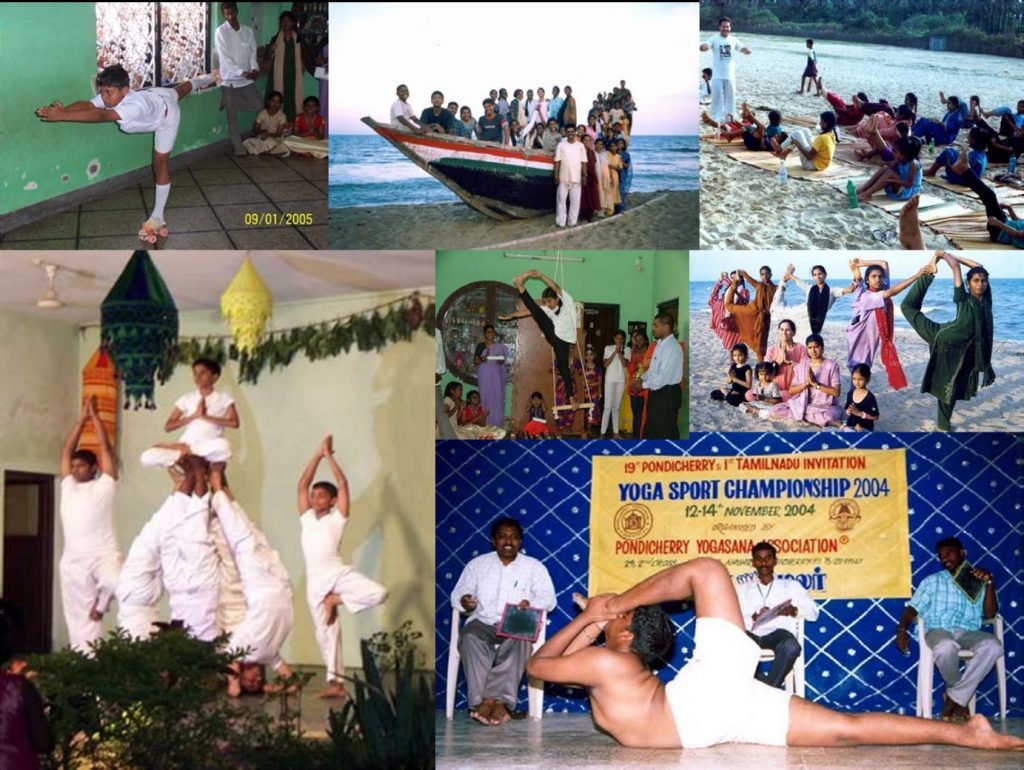
YOGA SPORT AS A TOOL TO REACH CHILDREN
Yoga in its holistic sense can never be competitive, and there are no objective measurement by which one person can be declared more Yogic than another. Therefore the term “competitive Yoga” is a paradox and has no real meaning. However, the proficiency of the Sadhaka can be compared with that of another in the performance of the Asanas, Kriyas, Mudras, Pranayamas and the Shat Karmas. Yogasana (Yoga Sport) competitions are a ‘fact’ in today’s Yoga world and are mushrooming up in all directions. When conducted efficiently and when the competitors approach them with the right Yogic attitude of ‘Nishkama Karma’, i.e. selfless action, then the Yogasana competitions have a lot to offer. They stimulate the young minds and give them an outlet for the competitive spirit, drive and energy. The youngsters learn to take the ‘win’ with the same equanimity (Samabhava) as the ‘loss’. They learn to accept that on any given day someone else may be better than them. They learn to accept the ‘highs’ with the ‘lows’ and realize that proper planning, dedicated and disciplined practice and enthusiastic participation is more important than the result. The youngsters are stimulated to intense practice and thus develop amazing body skills, which they may not develop otherwise. The competitions provide a meeting point for the youngsters to meet and interact positively with others having similar interests. Formation of a group of similar minded children can reinforce the individual’s practice whenever it slackens due to any reason. Positive ‘peer pressure’ creates a back-up to counter any inertia that may hinder the practitioner in their Sadhana. Due to competition, the child is shaken out of the complacency that tends to creep in when the practice of Yoga becomes a habit as monotonous as the brushing of teeth in the morning. They make sure that they don’t miss their practice and put in extra energy and time to keep in shape. The competitive edge sharpens and focuses the body awareness, thus fostering greater accuracy and perfection that in turn stimulates the real Yogic growth.
IMPORTANT YOGA PRACTICES FOR CHILDREN
- Play Yoga: Children can be allowed to watch their parents and siblings do Yoga practices from a young age as this stimulates a keen interest in the child’s mind. When they are ready they can be introduced to basic units of Yoga practices such as Chatus Pada Asanas and Kriya (moving around on all fours) where movement is a key element that helps to enthuse the child to join the Yoga fold. Loosening exercises and the Suryanamaskar are excellent tools for working with small children. Pawanamukta Kriya is an enjoyable introductory practice for small children.
- Asanas: Children find Asanas depicting animals of great interest and so Asanas like Ushtrasana, Shashahasana, Simhasana with Simha Nada, Gardhabakriya with Nada, Mayurasana, Bakasana, Kokilasana, Bhujangasana. Later on, more difficult Asanas may be introduced to induce interest and creativity in the children. The complicated Asanas also give the child a sense of achievement and positive self-image. Specific Asanas may also be used for the specific health disorders and these should be done in an individual one-on-one setting for maximum benefit. One-legged balancing postures such as Vrikshasana and Natarajasana help develop the concentration ability of the children while ‘head below the heart’ postures such as Padahasthasana, Padotannasana, Dharmikasana, Sashangasana Mehru Asana help induce a healthy flow of blood in the head region and are useful to improve memory and attention span. Shavasana is an excellent remedy for the stress that the modern child faces in the way of unrealistic educational expectations of teachers and parents. Asanas such as Ushtrasana and Bhujangasana are useful for children suffering Bronchial Asthma as they help to expand the chest in a proper manner. The groups of Asana termed the Hathenas are excellent for the benefit of asthmatic children and those suffering any sort of breathing disorder. Of course, attention must be paid to a healthy diet of citrus fruits and avoidance of mucus forming products such as chocolate and modern snacks. For children that need balancing of psychical imbalances the group of poses termed the Loma Viloma is an excellent remedy.
- Pranayamas: Kukkriya Pranayama (dog panting breath) is an all-time favorite with children. This is an excellent practice for toning up the abdominal organs and digestion will never be a problem. Mukha Bhastrika (cleaning breath) improves reaction time and thus is useful in all activities of the children including sports. The cooling Pranayamas are very useful in summer camps for the children if they are finding the heat intolerable and in addition to the Savitri and Pranava Pranayamas are beneficial in calming down hyperactive children. Vibhagha Pranayama (sectional breathing) teaches children how to breathe properly and relieves many breath-related disorders. Surya Pranayama is useful in the asthmatic child as it helps to relieve the bronco-constriction that is the hallmark of the disease. Children love to make sounds and the Brahmari Pranayama fulfils that need in addition to bringing about a serene calm.
- Kriyas: Children enjoy adventure and if the Shat Karmas are presented as an adventure they readily take them up as a challenge. It is not necessary that they do all of them but the Jala Neti and Kunjal Kriya are useful in those suffering from respiratory disorders. Older children can perform Kapalabhati and Nauli while all children can be taught Trataka as a concentration-improving practice. Modern children suffer numerous eye-related problems and Trataka and the Neti are highly beneficial for such children along with a diet rich in Vitamin A and C.
- Mudras: Bhujangini Mudra and Brahma Mudra are helpful as stress relievers in school-going children, though all enjoy them for their ‘play’ value. The Chin, Chinmaya, Adhi and Brahma Mudras are also useful in helping them to learn the sectional breathing in a proper manner. These Mudras also help them understand how the body affects the mind in a somato-psychic manner. Topsy-turvy Mudras such as Viparita Karani are not recommended in children before puberty or at least the age of ten, due to their powerful influence on the gonadal and other endocrine glands. Older children, as they go into adolescence, can be taught the Oli Mudras if they are ready, as these are wonderful tools for the transmutation of sexual urges into the higher Ojas and Tejas. However, they are very powerful practices and must be taught by a competent Guru to the ‘well prepared’ and ‘able’ youth.
- Relaxation: Relaxation is a must for modern children who face stress in so many ways. Unrealistic expectations at home, at school and powerful peer pressures virtually drive them mad. Shavasana and various relaxation practices from it can be taught to them. Breath awareness in Shavasana is a basic teaching that must be introduced to them at the earliest opportunity. Children must be made to realize that the benefits of all the practices come to them only when they relax at the end of a class. Kaya Kriya is an excellent body relaxer that helps children relax all aspects of the musculoskeletal system, while the Marmanasthanam Kriya keeps them in conscious relaxation. Older children may be taught higher practices, such as Yoga Nidra and the Anuloma Viloma Kriyas as required. They must also realize that ‘coming out’ of the relaxation is as important as the relaxation itself and that there is a way to ‘go in’ and ‘come out’ of the relaxation.
- Yoga theory: Children must be exposed to the various Yogic concepts that have guided people towards shaping their lives and the interpersonal relationships in their social life. Vasudeiva Kudumbakam (The whole world is one family) is an excellent concept that helps children to understand that division on the basis of class, creed, religion and geographical distribution are all ‘man made’ obstructions towards oneness. Pancha Kosha (the concept of our five sheaths or bodies) helps them understand how all their actions, emotions and even thoughts can influence their surroundings.
Chaturvidha Purusharthas (the four legitimate goals of life) shows them how to set goals for their future and work towards attaining them in the right way, following Dharma to attain Artha (material prosperity), Kama (emotional prosperity) and finally the attainment of the real goal of life, Moksha (spiritual prosperity). The concept of Chatur Ashramas helps them know how, what and when to perform the various activities in life. Concepts such as the Pancha Klesha (Avidya/ignorance, Asmita/ego, Raaga/attraction, Dwesha/repulsion and Abinivesha/urge to live at any cost) help them understand how these psycho-physiological afflictions control their lives.
Concepts of Karma Yoga such as Nishkama Karma (selfless action) and Karmasu Koushalam (skill in action) teach them ‘to do our best and leave the rest’. Children must be enabled to realize that a great artist, doctor, worker, singer or sportsman can be a Yogi by performing doing their duty to perfection and without care for the rewards of the action, even if they do not practice any Asana or Pranayama.
If the children are taught about the concept of Samatvam and the development of a complete personality that is neither affected by praise nor blame through development of Vairagya (detachment), they will be stimulated to follow such ideals in their lives. Such a child is a boon to society and a pleasure to live and work with.
Children must be exposed to the concepts of Yama and Niyama in order to provide a strong moral and ethical foundation for their personal and social life. This will guide their attitudes with regard to the right and wrong in life and in relation to their self, family unit and the entire social system.
These are values that need to be introduced to the youth in order to make them aware and conscious of these wonderful concepts of daily living, which are qualities to be imbibed with joy, and not learnt with fear or compulsion. The parents and teachers can, by example, show their children the importance of these qualities and when the children see the good examples of their parents and teachers living there principles they will surely follow suit sooner than later.
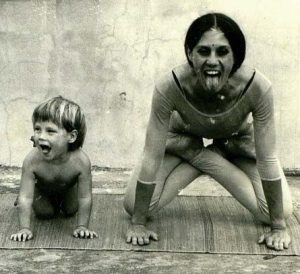
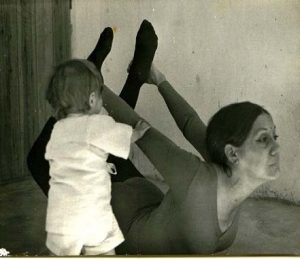
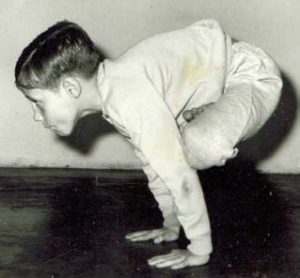
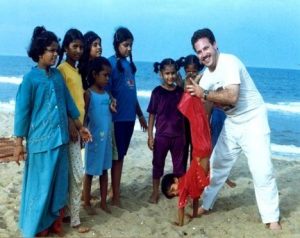
The author getting trained in Yoga from a young age by his mother, Ammaji Yogacharini Meenakshi Devi Bhavanani, Director ICYER at Ananda Ashram, Pondicherry, India and now joyfully continuing to spread the light of Yoga to the future generations through Yoganjali Natyalayam.